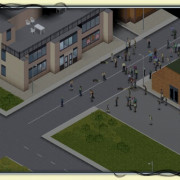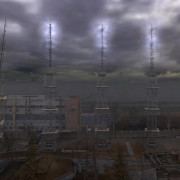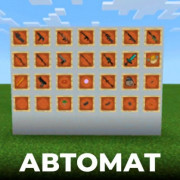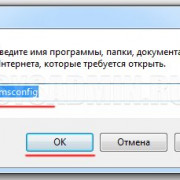Big reactors
Содержание:
- Гайд Big Reactors
- Turbine
- Construction
- BigReactor Simulator — Симуляция реакторов из BigReactors [Гайд]
- Reactor Parts[]
- Optimal High Speed Turbines (1840 RPM)[edit]
- Note[edit]
- Construction[edit]
- Turbine[edit]
- TODO — 0.5: The Exotic Coolant Update
- Reactor
- BigReactors.cfg
- TODO — 0.6: The Fueling Update
- Note[edit]
- Reactor[edit]
- Ресурсы
Гайд Big Reactors
Гайд по моду Big Reactors
Гайд по моду Big Reactors
Описание мода:Мод предназначен для выработки энергии в огромных количествах,реактор вы робатывает RF энергию.
Все реакторы строятся много-блочной структурой, минимальный размер ректора может быть 3х3х3, максимальных размеров(настраеватся в конфигах), его можно сделать просто невероятно огромным, все зависит от ваших ресурсов и вкусов!
Приступим к крафту блоков и постройке реактора!
Постройка реактора и описания блоков!
Для этого мода вам понадобятся такие ресурсы как:
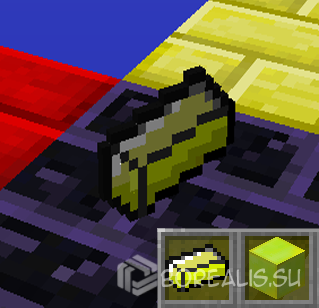
Добывается с Йеллориумовой руды
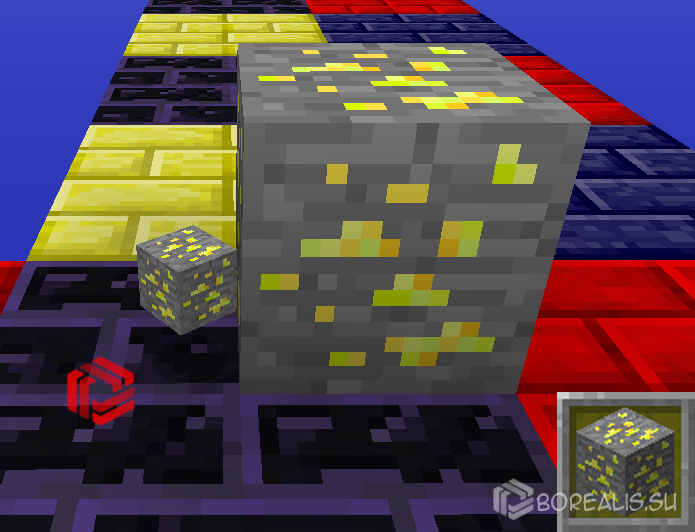
А если вы играете на серверах Sky Block то этот слиток можно добыть с помощью просеивания песка

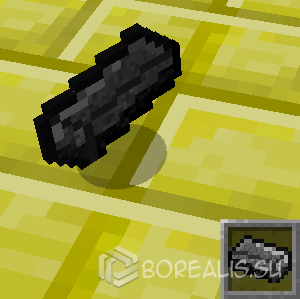
Добывается путем обжарки угля в любой печи(я покажу на примере Красной печи из Термала)

(Другие ресурсы и блоки во 3-ой части, на данном этапе они вам не нужны)
Реакторы пассивного охлаждения!
Для начало вам понадобится не мало таких блоков как: Корпус реактора
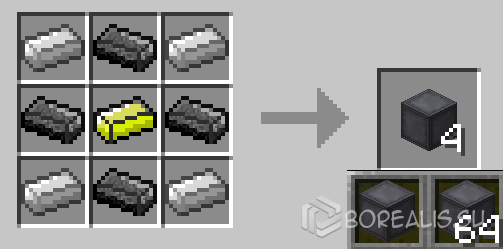
Блок управления реактором

Топливный стержень (количество данного блока зависит от высоты реактора)
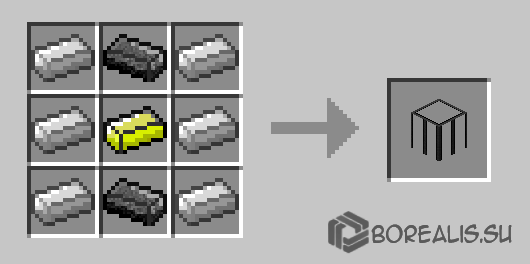
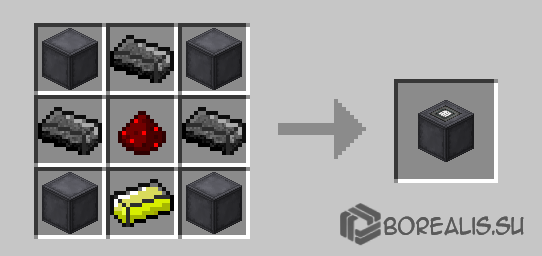
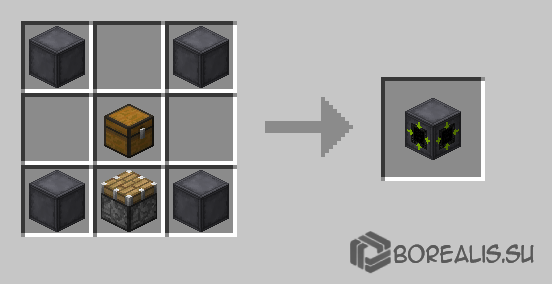
Стекло реактора (по жиланию)
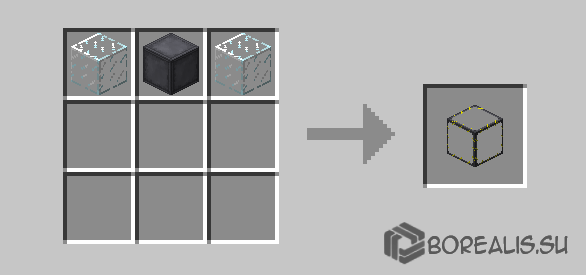
Розетка реактора( для вывода энергии)
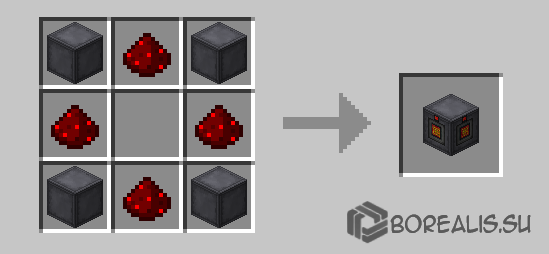
(можно поставить несколько, если ваш реактор больше чем 3х3х3)
Приступим к постройке реактора!
Как я и говорил в начале что реактор может быть самый малый 3х3х3, Будем рассматривать его!
Для начала строим площадку (дно реактора) 3х3 из корпусов реактора.
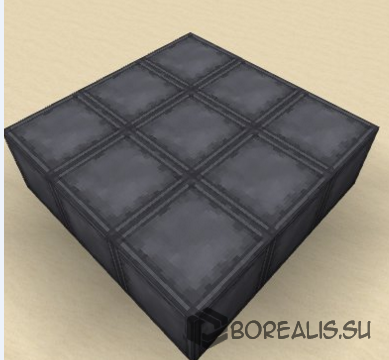
Далее ставим ребра в этой много-блочной форме
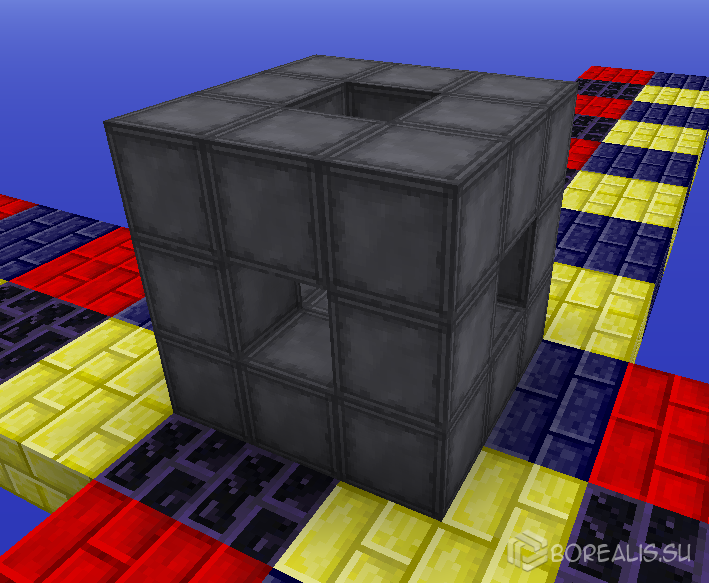
блок управления ставим в любую боковую часть, допустим вот так
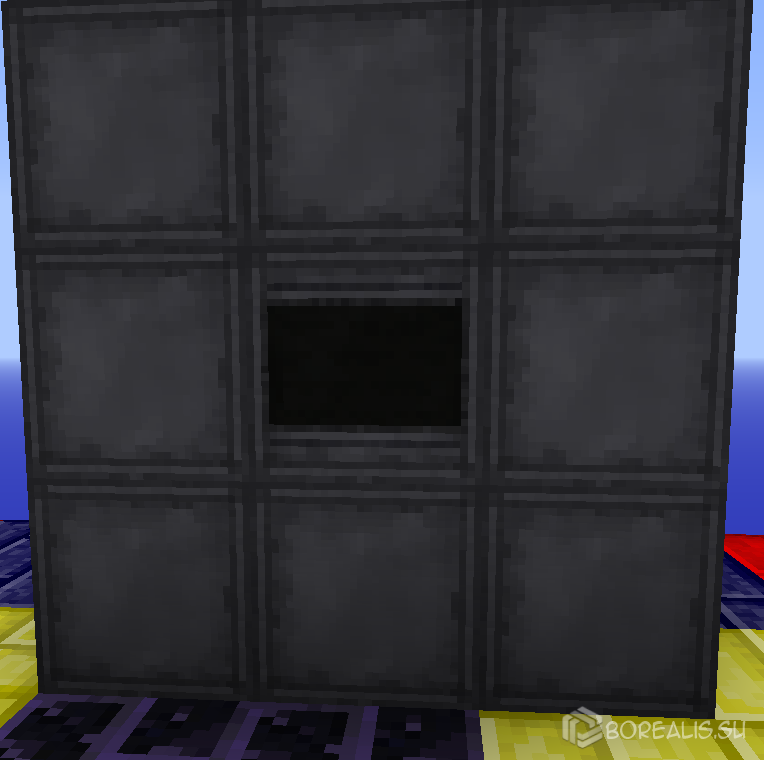
далее нам понадобятся порты,поставим их с 2-ух сторон желтый режим Вход, синий режим выход они нужны для ввода топлива, и вывода побочной продукции в виде слитка цианита О нем позже расскажу!

Так мы поставили блок управления и 2 порта, что же еще нам нужно? А нам нужен Топливный стержень ставим его как показано тут он должен идти от самого дна реактора, выше топливного стержня ставим Блок управления стержнями
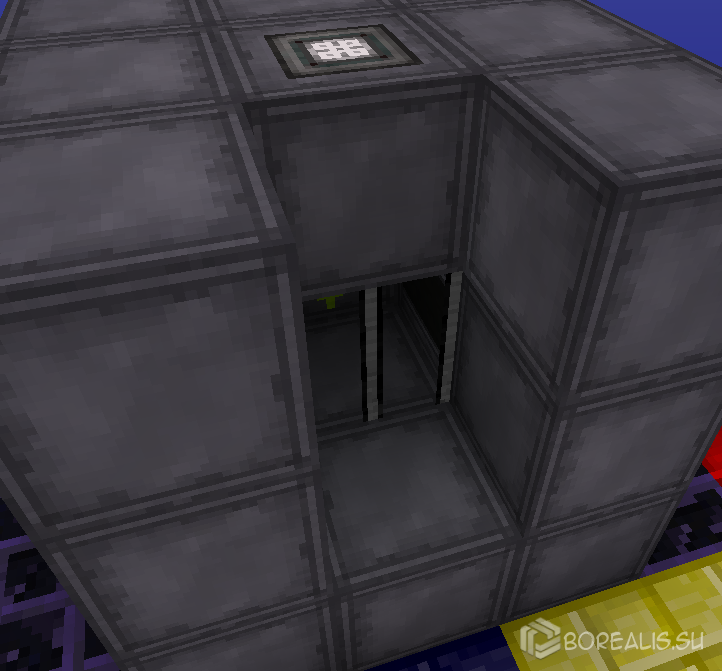
Ну и остался 1 блок у нас не закрытый, он нам нужен для розетки Когда вы все данные блоки поставите то ваш мини реактор примет нормальную форму

Интерфейс Блоков, их описание!
Начнем с главного блока, Блок управления
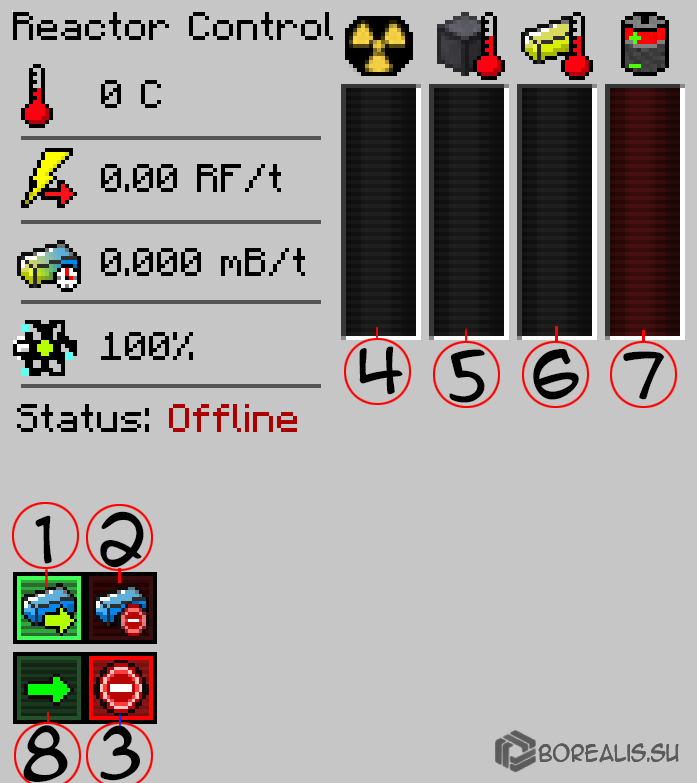
1. Кнопка для автоматического вынимания цианита из порта вывода с включенным синим выводом
2. Кнопка для отключения Автоматического вывода цианита
3. Кнопка отключения работы реактора
4. Буфер топливного стержня, показывает на сколько заполнен стержень топливом, сколько максимум он может в себя загрузить данного топлива, 1 слиток=1000mB, так же показывает процент выработки цианита
Источник
Turbine
A Turbine produces energy from Steam generated by an active cooling Reactor or generated using one of 6 other mods methods. Steam is converted back into water, which may be recycled into a Reactor to produce more steam.
Turbine Coil Material
The three values are always averaged together to give the resulting values for the entire turbine coil. A higher efficiency will always produce more power. A higher drag will produce more power, but will slow down the rotor more when induction is enabled. A higher bonus will also always produce more power.
| Block | Efficiency | Drag | Bonus |
|---|---|---|---|
| Iron Iron | 0.33 | 0.1 | 1 |
| Copper Copper | 0.396 | 0.12 | 1 |
| Osmium Osmium | 0.462 | 0.12 | 1 |
| Brass Brass | 0.462 | 0.12 | 1 |
| Aluminum Aluminum | 0.495 | 0.13 | 1 |
| Steel Steel | 0.495 | 0.13 | 1 |
| Invar Invar | 0.495 | 0.14 | 1 |
| Silver Silver | 0.561 | 0.15 | 1 |
| Gold Gold | 0.66 | 0.175 | 1 |
| Electrum Electrum | 0.825 | 0.2 | 1 |
| Fluxed Electrum Fluxed Electrum | 0.825 | 0.22 | 1.01 |
| Platinum Platinum | 0.99 | 0.25 | 1 |
| Shiny Shiny | 0.99 | 0.25 | 1 |
| Titanium Titanium | 1.023 | 0.27 | 1 |
| Enderium Enderium | 0.99 | 0.3 | 1.02 |
| Ludicrite Ludicrite | 1.155 | 0.35 | 1.02 |
| Mithril Mithril | 0.726 | 0.15 | 1 |
| Orichalcum Orichalcum | 0.759 | 0.17 | 1 |
| Quicksilver Quicksilver | 0.858 | 0.18 | 1 |
| Haderoth Haderoth | 0.99 | 0.2 | 1 |
| Celenegil Celenegil | 1.089 | 0.225 | 1 |
| Tartarite Tartarite | 0.99 | 0.25 | 1 |
Turbine Optimization
Optimized turbine designs for various coil materials
Turbines convert steam into water at an even ratio, and produce a certain amount of RF per tick depending on the coil material and turbine design.
Steam intake is always between 0 and 2,000 mB per tick.
The rotor speed gauge only shows between 0 and 2,200 RPM, but the actual rotor speed can be higher.
Generated energy is always positive or 0.
The width of the turbine frame is not a factor of energy output.
The number of rotor shafts isn’t a very large factor of energy output. Dimensions used are at the Player’s discretion.
If maximum rotor speed is unlimited and 2,000 mB per tick of steam is available, it is most efficient to use 80 rotor blades. If the rotor speed is limited to 2,000 RPM, perhaps more rotor shafts and fewer rotor blades would be preferable in order to keep the rotor speed above 1,796.27 but below 2,000 RPM while optimizing energy output.
All blocks of the coil do not need to be made of the same material, but are averaged together to determine the turbine’s score in each of the three coil traits. This makes it possible to make composite coils that use cheap filler metals in balance with high end metals to maximize limited resources. It also means, however, that adding a ring of a low performing metal to a turbine with several rings of a high-perfomance metal may actually reduce the output.
Turbine Equation
BladeSurfaceArea = Number of rotor blades in the turbine.
RotorMass = Total combined mass of the rotor blades and rotor shafts. See the table above for the mass of each block.
CoilSize = The number of coil blocks in the turbine.
InductorEfficiency, InductorDrag, InductorBonus = The average Efficiency, Drag, and Bonus of each coil block (from the table above).
RotorSpeed = The speed of the rotor as displayed in the turbine controller GUI.
Failed to parse (syntax error): {\displaystyle \text{TurbineEfficiency}= \begin{cases} 0.25 \left(\cos \left(\frac{\text{RotorSpeed}}{45.5 \pi }\right)+3\right) & \text{RotorSpeed}\geq 500 \\ 0.5 & \text{RotorSpeed}<500 \\ \end{cases} }
The turbine is at maximum efficiency (100%) at 898.134 RPM and 1796.27 RPM. It has an efficiency of 50% when less than 500 RPM, and at 1347.2 RPM. This doesn’t mean, however, that a turbine is most energy efficient at 1796 RPM.
Rotor energy in terms of ticks elapsed:
Where C is a constant that must be calculated based on initial values. If the turbine is just being started, then C is zero. OR, in terms of the RotorEnergy of the previous tick:
Rotor energy when turbine is running continuously:
a and b are both constant and are only dependent on the design of the turbine and the control values in the turbine controller.
If the turbine inductor is disengaged then InductionTorque equals zero.
Construction
File:Simple Big Reactor Animation.gif
Time lapse assembly of a small Reactor Structure.
Reactors and turbines are multi-block structures made up of individual blocks arranged according to specific rules, which together create a large functional machine. Both reactors and turbines must be built as a closed, mostly hollow box with no holes and complete edges, including corners. The edges of this box must be built from Reactor Casing or Turbine Housing blocks, and the faces of Reactor Glass or Turbine Glass blocks, respectively.
In addition to these containment blocks, a number of other blocks are necessary to make a functioning reactor or turbine. None of these blocks can be placed on the edge or corner; they must be somewhere in the faces of the reactor, sometimes in very specific places. Right clicking on the reactor casing or turbine housing will display a message of what is missing.
Important: Ensure that there aren’t any metallic blocks within a 1 block radius of the turbine! Doing so results in unpredictable behavior with the turbine.
Download this spreadsheet to calculate the required materials and their cost for any size Reactor structure.
Use this Big Reactor Simulator to test the efficiency of different Reactor designs.
BigReactor Simulator — Симуляция реакторов из BigReactors [Гайд]
BigReactor Simulator — Полезный инструмент для моделирования различных схем реакторов и их тестированию из мода BigReactors. Найти вебверсию можно тут:
Туториал по использованию
Создадим новую схему кликнув по кнопке New Reactor. Теперь нам потребуется ввести ширину, длину и высоту реактора. Эти значения определяют внутреннюю часть реактора, то есть стенки, пол и потолок не учитываются.
После того, как мы создали реактор снизу кое-что появится. Там можно найти результат симуляции, сколько ресурсов требуется на постройку реактора и другую информацию.
Во вкладке Costs перечислены материалы на реактор, в том числе более подробные. Очень полезно — сразу знаешь, что надо.
И так, теперь приступим к самому реактору. Допустим, выбираем креосиум и нажав на кнопку Fill заполняем им весь реактор.
Теперь поставим контрол роды.
Все! Схема готова, мы можем посмотреть сколько она генерирует энергии, потребляет топлива и что нужно для постройки.
Так-же можно сохранить схему или отправить другу. Адресная строка изменяется по мере изменения схемы и содержит всю информацию о реакторе. Просто отправляем куда надо, переходим по ней и остается та же схема.
Источник
Reactor Parts[]
Reactor Controller
All reactors must have exactly one Reactor Controller block. This block provides the main interface for monitoring the status of the reactor.
Reactor Access Port
Access Ports are buffers that contain unused fuel and waste. Right-clicking a port brings up an interface that allows to add fuel, remove waste, and toggle inlet/outlet mode. An active reactor will use the fuel from the ‘Inlet’ port and dump waste into the ‘Outlet’ port.
A Big Reactor needs at least one access port.
Yellorium Fuel Rod
The core of the reactor is an arrangement of Yellorium Fuel Rods. These must be stacked to stretch the entire interior height of the reactor. The entire volume of the reactor may be filled with fuel rods, but it does not have to be.
Reactor Control Rod
Above each stack of fuel rods there must be a Reactor Control Rod, this block tells the reactor where the fuel rods are so it can fill them with fuel.
Reactor Power Tap
Reactors that provide RF energy directly need to have at least one Reactor Power Tap as part of the structure.
The Power Tap can attach to any compatible Cable or Conduit that accepts RF power.
Reactor Coolant Port
Coolant Ports allow fluids to be injected into and drained from the reactor. Reactors that provide RF directly use coolant ports to keep the core at a safe operating temperature. Those that run steam turbines use coolant ports to feed the turbine with steam.
Reactor Computer Port
The Computer Port intalled on a Reactor, allows ComputerCraft blocks and items to control it.
Reactor RedNet Port
Like the Computer Port, the RedNet Port allows a reactor to interface with a RedNet network.
Optimal High Speed Turbines (1840 RPM)[edit]
- All optimal high speed turbines operate at 1840 RPM.
- Built with exactly 49 coil blocks. That’s 1 more than 6 complete rings.
- They use between 1800 and 2000 mB/t of steam.
- Longer turbines are marginally more efficient.
Enderium, Titanium, Platinum, Celengil, etc. are listed here for comparison. Although they operate at under 2000 RPM they behave like Ultra High Speed turbines. See above for the construction of their optimal designs.
| Block | Coils | Steam | Energy | RF/t/coil |
|---|---|---|---|---|
| Enderium | 37 | 1,800 | 24,075 | 650 |
| Titanium Titanium | 41 | 1,800 | 20,330 | 495 |
| Celenegil Celenegil | 49 | 1,800 | 21,640 | 440 |
| Platinum | 44 | 1,800 | 19,660 | 445 |
| Shiny | 44 | 1,800 | 19,660 | 445 |
| Tartarite Tartarite | 44 | 1,800 | 19,660 | 445 |
| Haderoth Haderoth | 70 | 1,820 | 17,650 | 360 |
| Electrum | 56 | 1,980 | 14,700 | 300 |
| Quicksilver Quicksilver | 46 | 1,980 | 13,760 | 280 |
| Orichalcum Orichalcum | 42 | 1,960 | 11,500 | 235 |
| Gold | 44 | 1,960 | 10,290 | 210 |
| Mithril Mithril | 35 | 1,940 | 9,700 | 200 |
| Silver | 36 | 1,820 | 7,500 | 150 |
| Invar | 32 | 1,930 | 6,800 | 125 |
| Steel | 29 | 1,930 | 5,730 | 115 |
| Aluminum | 29 | 1,930 | 5,730 | 115 |
| Brass | 26 | 1,980 | 4,940 | 100 |
| Osmium | 26 | 1,980 | 4,940 | 100 |
| Copper | 26 | 1,980 | 4,240 | 85 |
| Iron | 21 | 1,870 | 2,141 | 60 |
Note[edit]
- It is important to note that the coolant discussed in this section is completely unrelated to the Reactor Coolant Port. These would be more accurately described as the moderating material of the reactor, whereas the coolant port accepts only water for the generation of steam.
- Fantasy Metals: Mithril, Orichalcum, Quicksilver, Haderoth, Celenegil, Tartarite and Manyullyn may also be used as coolant material.
- ↑ Some of the materials above don’t work in the Big Reactor on MC 1.6.4
- As of v0.3.4A2, any material will have a mass of 10 units per block. In the future the mod developer plans to allow the rotor to be constructed out of different materials.
- ↑ These six materials only work if the use of fantasy metals is enabled in the Big Reactor config file.
Construction[edit]
Time lapse assembly of a small Reactor Structure.
Reactors and turbines are multi-block structures made up of individual blocks arranged according to specific rules, which together create a large functional machine. Both reactors and turbines must be built as a closed, mostly hollow box with no holes and complete edges, including corners. The edges of this box can be, but not necessarily built from Reactor Casing or Turbine Housing blocks, and the faces of Reactor Glass or Turbine Glass blocks, respectively.
In addition to these containment blocks, a number of other blocks are necessary to make a functioning reactor or turbine. None of these blocks can be placed on the edge or corner; they must be somewhere in the faces of the reactor, sometimes in very specific places. Right clicking on the reactor casing or turbine housing will display a message of what is missing.
Important: Ensure that there aren’t any metallic blocks within a 1 block radius of the turbine! Doing so results in unpredictable behavior with the turbine.
Turbine[edit]
A Turbine produces energy from Steam generated by an active cooling Reactor or generated using one of 6 other mods methods. Steam is converted back into water, which may be recycled into a Reactor to produce more steam.
Turbine Coil Materialedit
The three values are always averaged together to give the resulting values for the entire turbine coil. A higher efficiency will always produce more power. A higher drag will produce more power, but will slow down the rotor more when induction is enabled. A higher bonus will also always produce more power.
| Block | Efficiency | Drag | Bonus |
|---|---|---|---|
| Iron | 0.33 | 0.1 | 1 |
| Copper | 0.396 | 0.12 | 1 |
| Osmium | 0.462 | 0.12 | 1 |
| Brass | 0.462 | 0.12 | 1 |
| Aluminum | 0.495 | 0.13 | 1 |
| Steel | 0.495 | 0.13 | 1 |
| Invar | 0.495 | 0.14 | 1 |
| Silver | 0.561 | 0.15 | 1 |
| Gold | 0.66 | 0.175 | 1 |
| Electrum | 0.825 | 0.2 | 1 |
| Fluxed Electrum Fluxed Electrum | 0.825 | 0.22 | 1.01 |
| Platinum | 0.99 | 0.25 | 1 |
| Shiny Shiny | 0.99 | 0.25 | 1 |
| Titanium | 1.023 | 0.27 | 1 |
| Enderium Enderium | 0.99 | 0.3 | 1.02 |
| Ludicrite Ludicrite | 1.155 | 0.35 | 1.02 |
| Mithril | 0.726 | 0.15 | 1 |
| Orichalcum Orichalcum | 0.759 | 0.17 | 1 |
| Quicksilver | 0.858 | 0.18 | 1 |
| Haderoth Haderoth | 0.99 | 0.2 | 1 |
| Celenegil Celenegil | 1.089 | 0.225 | 1 |
| Tartarite Tartarite | 0.99 | 0.25 | 1 |
Turbine Optimizationedit
- Turbines convert steam into water at an even ratio, and produce a certain amount of RF per tick depending on the coil material and turbine design.
- Steam intake is always between 0 and 2,000 mB per tick.
- The rotor speed gauge only shows between 0 and 2,200 RPM, but the actual rotor speed can be higher.
- Generated energy is always positive or 0.
- The width of the turbine frame is not a factor of energy output.
- The number of rotor shafts isn’t a very large factor of energy output. Dimensions used are at the Player’s discretion.
- If maximum rotor speed is unlimited and 2,000 mB per tick of steam is available, it is most efficient to use 80 rotor blades. If the rotor speed is limited to 2,000 RPM, perhaps more rotor shafts and fewer rotor blades would be preferable in order to keep the rotor speed above 1,796.27 but below 2,000 RPM while optimizing energy output.
- All blocks of the coil do not need to be made of the same material, but are averaged together to determine the turbine’s score in each of the three coil traits. This makes it possible to make composite coils that use cheap filler metals in balance with high end metals to maximize limited resources. It also means, however, that adding a ring of a low performing metal to a turbine with several rings of a high-perfomance metal may actually reduce the output.
Turbine Equationedit
- BladeSurfaceArea = Number of rotor blades in the turbine.
- RotorMass = Total combined mass of the rotor blades and rotor shafts. See the table above for the mass of each block.
- CoilSize = The number of coil blocks in the turbine.
- InductorEfficiency, InductorDrag, InductorBonus = The average Efficiency, Drag, and Bonus of each coil block (from the table above).
- RotorSpeed = The speed of the rotor as displayed in the turbine controller GUI.
The turbine is at maximum efficiency (100%) at 898.134 RPM and 1796.27 RPM. It has an efficiency of 50% when less than 500 RPM, and at 1347.2 RPM. This doesn’t mean, however, that a turbine is most energy efficient at 1796 RPM.
Rotor energy in terms of ticks elapsed:
Where C is a constant that must be calculated based on initial values. If the turbine is just being started, then C is zero. OR, in terms of the RotorEnergy of the previous tick:
Rotor energy when turbine is running continuously:
a and b are both constant and are only dependent on the design of the turbine and the control values in the turbine controller.
If the turbine inductor is disengaged then InductionTorque equals zero.
TODO — 0.5: The Exotic Coolant Update
Internals
- Coolant fluid pairs can be registered in a registry, allowing different types of fluids to be used as coolants
- Rebalance reactor interior list so it’s not just a race to enderium
- Make blocks mostly good at either generating energy OR moderating radiation, not both
- Moderators improve as they become more transparent to slow radiation
- Generators improve as they become less transparent to slow radiation
Multiblock Turbine
- Optional explosion during severe overspeed conditions
- Redstone port.
- Different types of rotors and blades, made of different metals
- Additional very-high-end coil parts that extract Gratuitous Amounts of Energy
Heat Exchanger
- Big multiblock machine which converts exotic coolants into steam
- Absorbs heat from exotic coolants into heat buffer, transfers buffered heat to water tank to create steam
- Has «special steam» modes which create compressed steam (x10 energy), ultradense steam (x100 energy) and steamium (x1000 energy)
- Primary fluid inlet accepts all mapped fluid pairs from coolant registry
Multiblock Reactor
- Coolant manifolds inside reactor add extra surface area — must be adjacent to casing, other manifold or fuel rod
- Coolant inlet accepts all mapped fluid pairs from coolant registry
- Add reactivity penalty to control rods, so a reactor with high control rod insertion is less efficient than a smaller reactor with lower insertion. Encourages right-sizing designs.
Reactor
Parts
Reactor Controller64px
All reactors must have exactly one Reactor Controller block, which provides the main interface for monitoring the status of the reactor.
Reactor Access Port
64px
Access Ports are buffers that contain unused fuel and waste. Right-clicking a port brings up an interface that allows to add fuel, remove waste, and toggle inlet/outlet mode. An active reactor will use the fuel from the ‘Inlet’ port and dump waste into the ‘Outlet’ port. A Big Reactor needs at least one access port.
Yellorium Fuel Rod
64px
The core of the reactor is an arrangement of Yellorium Fuel Rods. These must be stacked to stretch the entire interior height of the reactor. The entire volume of the reactor may be filled with fuel rods, but it does not have to be. The Reactor will be most efficient with the Fuel Rods placed diagonally in a checker board pattern with a coolant filling the gaps.
Reactor Control Rod
64px
Above each stack of Fuel Rods there must be a Reactor Control Rod, which allows the Player to adjust the depth of the Rod. It also tells the reactor where the fuel rods are so it can fill them with fuel.
Reactor Power Tap
64px
Reactors that provide RF energy directly need to have at least one Reactor Power Tap as part of the structure.
The Power Tap can attach to any compatible Cable or Conduit that accepts RF power.
Reactor Coolant Port
64px
Coolant Ports allow fluids to be injected into and steam drained from the reactor to be transported to feed a turbine.
Reactor Computer Port64px
The Computer Port installed on a Reactor, allows ComputerCraft and OpenComputers blocks and items to control it.
Reactor RedNet Port64px
Like the Computer Port, the RedNet Port allows a reactor to interface with a RedNet network.
Reactor Temperature
The fuel inside the fuel rods generates power, radiation and heat. Heat is transferred to the adjacent 4 blocks from the fuel rods into a coolant or fuel rod block, and likewise radiation is transferred up to 4 blocks (dependant on adjacent block absorption) in the cardinal directions (North,South,East,West).
Excess radiation and heat could cause the temperature in the reactor to rise above efficient levels and consume more fuel, since there is a penalty to fuel consumption at too high an operating temperature.
| Temperature (C) | < 200 | 200 to 1000 | 1000 to 2000 |
|---|---|---|---|
| Loss (%) | None | 0 to 10 | 10 to 66 |
Reactor Coolant
A coolant reduces the temperature of a reactor, and moves heat from the reactor core to the reactor casing. The higher the casing heat, the higher the energy output and heat transfer rate of coolants .
Any fluid used as coolant must be manually added to the reactor during construction, exactly as you would with solid coolant materials. Those looking to fill large reactors with fluids that fall, such as Gelid Cryotheum, may want to consider using a Flood Gate.
Each coolant material has various parameters that govern how it affects the reactor :
Absorption: How much radiation this material absorbs and converts to heat. Ranges from 0 (none) to 1 (all).
Heat Efficiency: How efficiently radiation is converted to heat. Ranges from 0 (none) to 1 (all).
Moderation: How well this material moderates radiation. This is a divisor, and greater than or equal to 1.
Conductivity: Amount of heat transfered on each exposed face.
| Block | Absorption | Heat Efficiency | Moderation | Conductivity |
|---|---|---|---|---|
| Iron Iron | 0.5 | 0.75 | 1.4 | 0.6 |
| Gold Gold | 0.52 | 0.8 | 1.45 | 2 |
| Diamond Diamond | 0.55 | 0.85 | 1.5 | 3 |
| Emerald Emerald | 0.55 | 0.85 | 1.5 | 2.5 |
| Graphite Graphite | 0.1 | 0.5 | 2 | 2 |
| Glass Glass | 0.2 | 0.25 | 1.1 | 0.3 |
| Ice Ice | 0.33 | 0.33 | 1.15 | 0.1 |
| Snow Snow | 0.15 | 0.33 | 1.05 | 0.05 |
| Copper Copper | 0.5 | 0.75 | 1.4 | 1 |
| Osmium Osmium | 0.51 | 0.77 | 1.41 | 1 |
| Brass Brass | 0.51 | 0.77 | 1.41 | 1 |
| Bronze Bronze | 0.51 | 0.77 | 1.41 | 1 |
| Zinc Zinc | 0.51 | 0.77 | 1.41 | 1 |
| Aluminum Aluminum | 0.5 | 0.78 | 1.42 | 0.6 |
| Steel Steel | 0.5 | 0.78 | 1.42 | 0.6 |
| Invar Invar | 0.5 | 0.79 | 1.43 | 0.6 |
| Silver Silver | 0.51 | 0.79 | 1.43 | 1.5 |
| Lead Lead | 0.75 | 0.75 | 1.75 | 1.5 |
| Electrum Electrum | 0.53 | 0.82 | 1.47 | 2.2 |
| Fluxed Electrum Fluxed Electrum | 0.54 | 0.83 | 1.48 | 2.4 |
| Platinum Platinum | 0.53 | 0.86 | 1.58 | 2.5 |
| Shiny Shiny | 0.53 | 0.86 | 1.58 | 2.5 |
| Titanium Titanium | 0.53 | 0.87 | 1.59 | 2.7 |
| Enderium Enderium | 0.53 | 0.88 | 1.6 | 3 |
| Water Water | 0.33 | 0.5 | 1.33 | 0.1 |
| Destabilized Redstone Destabilized Redstone | 0.75 | 0.55 | 1.6 | 2.5 |
| Energized Glowstone Energized Glowstone | 0.2 | 0.6 | 1.75 | 1 |
| Gelid Cryotheum Gelid Cryotheum | 0.66 | 0.95 | 6.0 | 3 |
| Resonant Ender Resonant Ender | 0.9 | 0.75 | 2.0 | 2 |
| Blazing Pyrotheum Blazing Pyrotheum | 0.66 | 0.9 | 1.0 | 0.6 |
| Life Essence Life Essence | 0.7 | 0.55 | 1.75 | 2 |
BigReactors.cfg
GenerateYelloriteOre=true – включить генерацию Yellorite в мире. Рекомендуется отключить, если в клиенте установлен IC2 во избежание дисбаланса в игре, т.к. при обжигании руды игрок сразу получит обогащенный уран. Автозамена Yellorite Ingot на слитки урана отключается параметром autoAddUranium=false, но большой разницы я не вижу: фактически, будет один вид «халявного» топлива, и один не очень… Для «честной» игры с IC2 лучше руду не включать и использовать уран.
Запасы Yellorium Ore в мире так же настраиваются: количество кластеров, их размер, амплитуда высот.
enableWorldGen=true — генерация руды Yellorite включена для всех биомов, кроме Нижнего мира и Края.
enableWorldRegeneration=false – генерация руды в уже созданном чанке. По-умолчанию отключена.
Для тех, кому кажется, что количество вырабатываемой энергии в аддоне слишком завышено, существует коэффициент в параметре powerProductionMultiplier – множитель мощности реакторов. Другой вариант — указать максимальные размеры каркаса: maxReactorHeight (высота) и maxReactorSize (длина и ширина), тем самым ограничив энергетические мощности машин.

Аддон появился совсем недавно, еще даже не вышел со стадии альфа-тестирования, тем не менее, он заслуживает внимания. Это то, чего так долго не хватало BuildCraft’у! Возможно, Big Reactors еще пока не сбалансирован, забагован и сырой, но в будущем автор обещает его намного усложнить и разнообразить.
На этом все. С вами был therapy session, wiki, google-translate, paint.net, ms word, немного энтузиазма и замечательное творение от Erogenous Beef — Big Reactors. Удачи в начинаниях и развитии!
TODO — 0.6: The Fueling Update
Reactor Mechanics
- Blutonium: give it different properties than yellorium.
- Blutonium: Create a proper fluid for it so it can be handled as a first-class member of the fuel cycle
- Add fluid fuel interfaces & magma crucible recipes for TE to fluidize fuel
- Add «fluidizer» small machine — consumes power, outputs fluid fuel
- Add «fluidic reprocessor» small machine — reprocesses fluid wastes into fluid fuels
- Allow mixed reactants inside reactor, so long as their products are identical
Reactor meltdowns
- Add option to enable reactor meltdowns to config
- When overheated, low chance of meltdown, based on heat.
- When meltdown occurs:
— Reactor disassembles
— One or more fuel rod blocks convert to corium fluid at the reactor’s bottom
— Zero or more explosions near the reactor’s top - Corium fluid acts like acid; slowly eats through materials beneath it.
- Touching corium fluid swiftly kills the shit out of you.
- Corium fluid eventually hardens into corium.
- Touching corium damages and withers you.
Note[edit]
- It is important to note that the coolant discussed in this section is completely unrelated to the Reactor Coolant Port. These would be more accurately described as the moderating material of the reactor, whereas the coolant port accepts only water for the generation of steam.
- Fantasy Metals: Mithril, Orichalcum, Quicksilver, Haderoth, Celenegil, Tartarite and Manyullyn may also be used as coolant material.
- ↑ Some of the materials above don’t work in the Big Reactor on MC 1.6.4
- As of v0.3.4A2, any material will have a mass of 10 units per block. In the future the mod developer plans to allow the rotor to be constructed out of different materials.
- ↑ These six materials only work if the use of fantasy metals is enabled in the Big Reactor config file.
Reactor[edit]
Partsedit
Reactor Controller
All reactors must have exactly one Reactor Controller block, which provides the main interface for monitoring the status of the reactor.
Access Ports are buffers that contain unused fuel and waste. Right-clicking a port brings up an interface that allows to add fuel, remove waste, and toggle inlet/outlet mode. An active reactor will use the fuel from the ‘Inlet’ port and dump waste into the ‘Outlet’ port. A Big Reactor needs at least one access port.
The core of the reactor is an arrangement of Yellorium Fuel Rods. These must be stacked to stretch the entire interior height of the reactor. The entire volume of the reactor may be filled with fuel rods, but it does not have to be. The Reactor will usually be more efficient with the Fuel Rods placed diagonally in a checker board pattern with a coolant filling the gaps.
Above each stack of Fuel Rods there must be a Reactor Control Rod, which allows the Player to adjust the depth of the Rod. It also tells the reactor where the fuel rods are so it can fill them with fuel.
Reactors that provide RF energy directly need to have at least one Reactor Power Tap as part of the structure.
The Power Tap can attach to any compatible Cable or Conduit that accepts RF power.
Coolant Ports allow fluids to be injected into and steam drained from the reactor to be transported to feed a turbine.
Reactor Computer Port
The Computer Port installed on a Reactor, allows ComputerCraft and OpenComputers blocks and items to control it.
Reactor RedNet Port
Like the Computer Port, the RedNet Port allows a reactor to interface with a RedNet network.
Reactor Temperatureedit
The fuel inside the fuel rods generates power, radiation and heat. Heat is transferred to the adjacent 4 blocks from the fuel rods into a coolant or fuel rod block, and likewise radiation is transferred up to 4 blocks (dependant on adjacent block absorption) in the cardinal directions (North,South,East,West).
Excess radiation and heat could cause the temperature in the reactor to rise above efficient levels and consume more fuel, since there is a penalty to fuel consumption at too high an operating temperature.
| Temperature (C) | < 200 | 200 to 1000 | 1000 to 2000 |
|---|---|---|---|
| Loss (%) | None | 0 to 10 | 10 to 66 |
Reactor Coolantedit
A coolant reduces the temperature of a reactor, and moves heat from the reactor core to the reactor casing. The higher the casing heat, the higher the energy output and heat transfer rate of coolants .
Any fluid used as coolant must be manually added to the reactor during construction, exactly as you would with solid coolant materials. Those looking to fill large reactors with fluids that fall, such as Gelid Cryotheum, may want to consider using a Flood Gate of Fluid Outlet.
Each coolant material has various parameters that govern how it affects the reactor :
- Absorption: How much radiation this material absorbs to convert to heat. Ranges from 0 (none) to 1 (all).
- Heat Efficiency: How efficiently absorbed radiation is converted to heat. Ranges from 0 (none) to 1 (all).
- Moderation: How well this material moderates radiation. This is a divisor, and greater than or equal to 1.
- Conductivity: Amount of heat transfered on each exposed face.
| Block | Absorption | Heat Efficiency | Moderation | Conductivity |
|---|---|---|---|---|
| Iron | 0.5 | 0.75 | 1.4 | 0.6 |
| Gold | 0.52 | 0.8 | 1.45 | 2 |
| Diamond | 0.55 | 0.85 | 1.5 | 3 |
| Emerald | 0.55 | 0.85 | 1.5 | 2.5 |
| Graphite | 0.1 | 0.5 | 2 | 2 |
| Glass | 0.2 | 0.25 | 1.1 | 0.3 |
| Ice | 0.33 | 0.33 | 1.15 | 0.1 |
| Snow | 0.15 | 0.33 | 1.05 | 0.05 |
| Copper | 0.5 | 0.75 | 1.4 | 1 |
| Osmium | 0.51 | 0.77 | 1.41 | 1 |
| Brass | 0.51 | 0.77 | 1.41 | 1 |
| Bronze | 0.51 | 0.77 | 1.41 | 1 |
| Zinc | 0.51 | 0.77 | 1.41 | 1 |
| Aluminum | 0.5 | 0.78 | 1.42 | 0.6 |
| Steel | 0.5 | 0.78 | 1.42 | 0.6 |
| Invar | 0.5 | 0.79 | 1.43 | 0.6 |
| Silver | 0.51 | 0.79 | 1.43 | 1.5 |
| Lead | 0.75 | 0.75 | 1.75 | 1.5 |
| Electrum | 0.53 | 0.82 | 1.47 | 2.2 |
| Fluxed Electrum | 0.54 | 0.83 | 1.48 | 2.4 |
| Platinum | 0.53 | 0.86 | 1.58 | 2.5 |
| Shiny | 0.53 | 0.86 | 1.58 | 2.5 |
| Titanium Titanium | 0.53 | 0.87 | 1.59 | 2.7 |
| Enderium | 0.53 | 0.88 | 1.6 | 3 |
| Water | 0.33 | 0.5 | 1.33 | 0.1 |
| Destabilized Redstone | 0.75 | 0.55 | 1.6 | 2.5 |
| Energized Glowstone | 0.2 | 0.6 | 1.75 | 1 |
| Gelid Cryotheum | 0.66 | 0.95 | 6.0 | 3 |
| Resonant Ender | 0.9 | 0.75 | 2.0 | 2 |
| Blazing Pyrotheum | 0.66 | 0.9 | 1.0 | 0.6 |
| Life Essence | 0.7 | 0.55 | 1.75 | 2 |
Ресурсы
| Yellorite Ore – руда, добавленная в генерацию мира. Основной ресурс, с которого можно получить топливо для реактора. | |
| Yellorium Ingot – крафтится путем переплавки Yellorite Ore или Yellorite Dust в печи. Используются как основной вид топлива для реактора: производит энергию, тепло и Cyanite Ingot (отходы). Если установлен IC2, вместо Yellorium игрок получит сразу обогащенный уран*. | |
| Cyanite Ingot – отработанный ресурс в реакторе. Получается путем отработки Yellorium или Blutonium в реакторе. | |
| Blutonium Ingot – переработанный Cyanite Ingot в блоке Cyanite Reprocessor. Используется как топливо для реактора: вырабатывает энергию, тепло и снова Cyanite Ingot. По-сути, не имеет отличий с Yellorium Ingot в плане производства энергии и тепла. | |
| Graphite Bar – материал, используемый для цепочек крафта множества блоков реактора. Можно получить путем обжигания угля или древесного угля в печи. |









